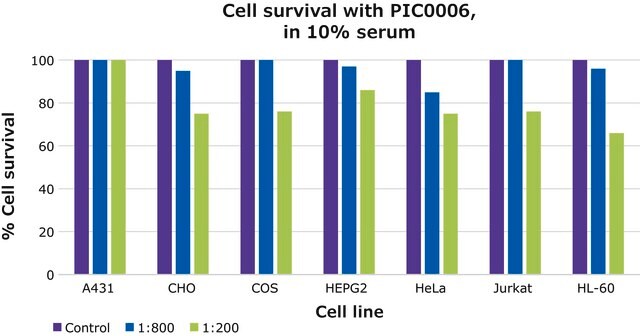539133
Protease Inhibitor Cocktail VI
liquid, for the inhibition of proteases and esterases. This small molecule/inhibitor is primarily used for Protease Inhibitors applications.
Synonyme(s) :
Protease inhibitor cocktail
About This Item
Produits recommandés
Nom du produit
Protease Inhibitor Cocktail Set VI, The Protease Inhibitor Cocktail Set VI controls the activity of Protease. This small molecule/inhibitor is primarily used for Protease Inhibitors applications.
Forme
liquid
Fabricant/nom de marque
Calbiochem®
Conditions de stockage
OK to freeze
Conditions d'expédition
wet ice
Température de stockage
−20°C
Description générale
This cocktail is provided as a single vial of 1 ml, or as a package of 5 x 1 ml vials. Each vial contains the inhibitors solubilized in DMSO at the following concentrations:
Spécificité
Actions biochimiques/physiologiques
Aspartic, cysteine, serine, and metalloproteases as well as aminopeptidases.
Avertissement
Forme physique
Informations légales
Mention d'avertissement
Danger
Mentions de danger
Conseils de prudence
Classification des risques
Acute Tox. 4 Oral - Aquatic Acute 1 - Aquatic Chronic 1 - Eye Dam. 1 - Skin Irrit. 2
Code de la classe de stockage
10 - Combustible liquids
Classe de danger pour l'eau (WGK)
WGK 3
Point d'éclair (°F)
188.6 °F
Point d'éclair (°C)
87 °C
Certificats d'analyse (COA)
Recherchez un Certificats d'analyse (COA) en saisissant le numéro de lot du produit. Les numéros de lot figurent sur l'étiquette du produit après les mots "Lot" ou "Batch".
Déjà en possession de ce produit ?
Retrouvez la documentation relative aux produits que vous avez récemment achetés dans la Bibliothèque de documents.
Notre équipe de scientifiques dispose d'une expérience dans tous les secteurs de la recherche, notamment en sciences de la vie, science des matériaux, synthèse chimique, chromatographie, analyse et dans de nombreux autres domaines..
Contacter notre Service technique











